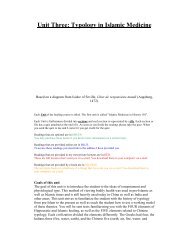Beginning Iridology Guide - Weebly
Beginning Iridology Guide - Weebly
Beginning Iridology Guide - Weebly
Create successful ePaper yourself
Turn your PDF publications into a flip-book with our unique Google optimized e-Paper software.
We judge the quality of the constitution of an individual according to the absence or<br />
presence in the iris of the various hereditary and acquired taints, encumbrances and<br />
defects.<br />
The life expectancy of an individual can be estimated by the quality of his<br />
constitution as revealed in the iris. Frequently, however, individuals with frail<br />
constitutions carefully nurse their health and outlive those with vigorous constitutions<br />
who recklessly squander their vitality. According to the showing in the iris of color,<br />
density and hereditary lesions, we distinguish four types of constitutions. The ideal, as<br />
before stated, we do not find in human beings. We therefore have not given it a place<br />
in the drawing (Fig. 6) which illustrates the four degrees of density.<br />
Four Degrees of Density<br />
(Fig. 6, p. 42)<br />
Section 1. Good. We notice only a few straight, whitish lines. This iris is sometimes<br />
found in infants and young children, and in sailors and mountaineers.<br />
Section 2. Common. The white lines are increased and more tangled. There are a<br />
few hereditary lesions and some dark lines indicating subacute, catarrhal conditions;<br />
also some nerve rings. Individuals exhibiting this degree of density may enjoy good<br />
health in the usual sense of the term.<br />
Section 3. Poor. In this section white lines are more prominent and tangled. It<br />
contains several nerve rings. Signs of subacute and chronic conditions are more<br />
numerous. There are several closed defects. Individuals of this type are usually trying<br />
one "cure" after another.<br />
Section 4. Very Poor. In this section signs of chronic and destructive chronic<br />
conditions predominate. The nerve rings are partially dark. Closed lesions as in<br />
Section 3. Prognosis not promising.<br />
4. Physiological type<br />
The Normal Colors of the Iris<br />
As described in Chapter IV, there are only two normal iris colors,--light azure blue<br />
and light hazel brown.<br />
I. The stroma of the blue iris is devoid of pigment, thus allowing the purple pigment<br />
layer to shimmer through as a uniform, clear sky blue.<br />
II. In the normal brown iris the connective tissue cells of the stroma contain a brown<br />
pigment, which totally obscures the purple pigment layer, thus imparting a uniform,<br />
clear light brown color to the iris.<br />
The albino iris contains no pigment either in the connective tissue cells of the<br />
stroma or in the pigment layer. The resulting transparency renders the blood vessels<br />
visible, hence the iris presents a delicate pink appearance.




